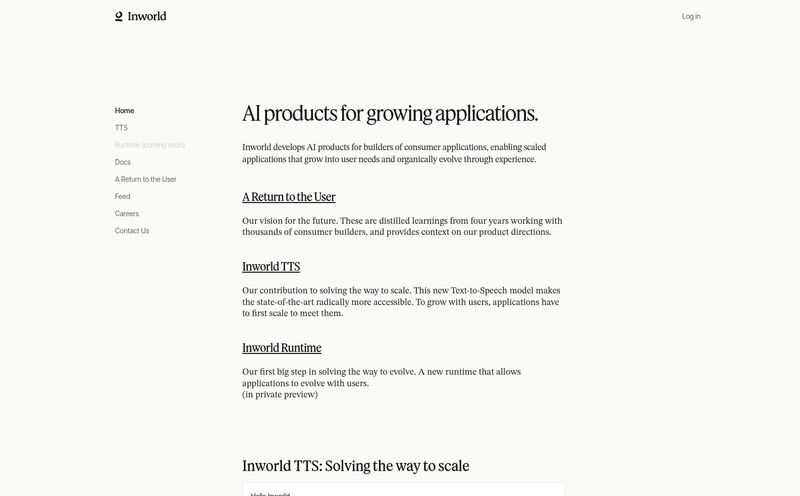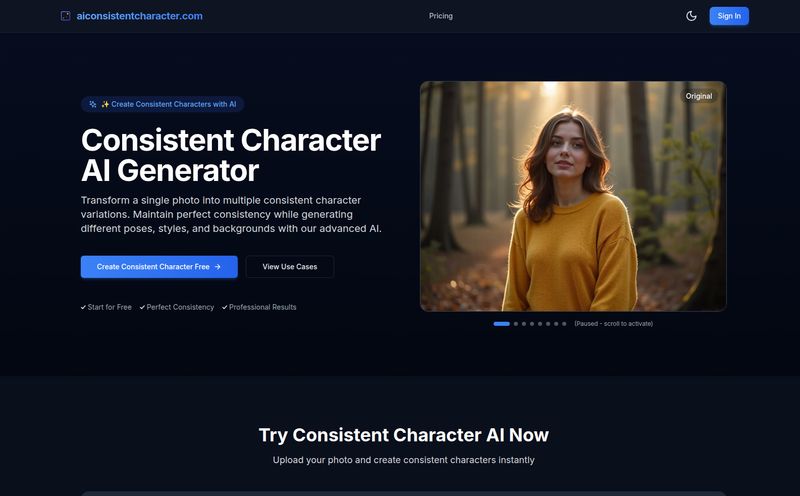I’ve been in the SEO and digital trends game for a while now. Long enough to remember when 'AI' was just something you saw in movies, usually before it tried to take over the world. Now, it feels like every other startup is bolting a chatbot onto their website. Most of them are... fine. You know, the kind that can answer basic questions but folds the second you ask it something slightly off-script. It's like talking to an automated phone menu. Frustrating.
So, when I heard about RealChar, my ears perked up. The pitch is seductive: create and chat with custom AI characters in real-time. Not just a generic bot, but a character. Your own creation. And it’s powered by the big dogs of the AI world, OpenAI’s GPT-4 and Anthropic’s Claude 2. That’s like putting a Formula 1 engine in a go-kart. The potential is massive.
Naturally, I had to check it out. I navigated to their site, full of excitement, ready to build an AI version of a cynical SEO blogger to see if it could mock my own articles. And I was greeted with... well, this.

Visit RealChar
An error. A classic server error. It’s the digital equivalent of showing up for a date and finding the restaurant isn't built yet. But honestly? It just made me more curious. This is the sign of something either catastrophically broken or so new and experimental that it’s still got the scaffolding up. Let’s figure out which it is.
So, What Exactly is RealChar Supposed to Be?
Putting the server issues aside for a moment, let's talk about the dream. RealChar isn't just another chatbot interface. It's a platform for creating AI companions. Think of it less as a tool and more as a character creation screen from a video game. You get to define your AI's personality, its backstory, and then interact with it. The goal is a natural, seamless conversation that feels less like querying a database and more like, you know, talking.
And they’re aiming for this to work everywhere. The platform is designed for multi-platform support. You can chat on the web, on your phone, and even in a command-line terminal. And when I say terminal, I mean that beautiful, black-screen-with-green-text that makes you feel like a hacker in a 90s movie. I have a soft spot for that kind of nerdy detail.
The Heavy Hitters Powering Your New AI Friends
Here’s the thing that really separates RealChar from the pack: its brain. It's not running on some proprietary, no-name language model. It integrates with OpenAI's GPT-4 and Anthropic's Claude 2. For those not deep in the AI weeds, that’s a huge deal.
These are two of the most advanced and nuanced Large Language Models (LLMs) available. They’re the reason AI-generated text has gone from clunky and weird to terrifyingly human-like in just a few years. Using these models means conversations with a RealChar character have the potential for genuine depth, memory, and personality. It’s the difference between a puppet with pre-written lines and a master improv actor. It’s a bold choice, and probably an expensive one for the developers, which tells me they’re serious about conversation quality.
The Promise of RealChar: When the Server Cooperates
Okay, so we can’t log in right now. Let’s be optimistic and assume the server is just taking a coffee break. What are we missing out on? Based on their mission, the experience is all about bringing your own AI to life.
Create Your Ideal Conversational Partner
The customization is the core feature. You're not just picking from a list of pre-made bots. You are the creator. This opens up some wild possibilities. A writer could create characters from their novel to workshop dialogue. Someone learning a new language could create a patient, native-speaking practice partner. Or, yes, you could just create a friendly companion to chat with about your day. It’s a digital sandbox for personalities.
Real-time Conversations That Feel… Real?
The emphasis on “real-time” and “seamless” conversation suggests this is more than just text. We’re likely talking about fast, responsive voice-to-voice interaction. The kind of thing that eliminates that awkward pause while you wait for the AI to “think.” This is the holy grail of conversational AI—making it feel as natural as talking to a person. If they can pull this off, it would be a game-changer.
The Big Question: What About Pricing?
Here's another mystery. There’s no pricing information available. Zilch. Nada. The pricing page is as empty as the server response. This could mean a few things:
- It’s currently free while in its early beta/alpha phase.
- They haven't decided on a model yet.
- It will eventually be a 'bring your own API key' model, where you pay OpenAI or Anthropic directly for usage.
My money is on a combination of the first two. For a tool this experimental (we're talking version 0.0.11, according to the docs), it's smart to build a user base first and worry about monetization later. But be prepared for that to change once it's more stable.
A Healthy Dose of Skepticism
As exciting as this all is, we need to keep our feet on the ground. One of the official “cons” listed for the platform is that “AI character statements are fictional and may not be accurate.” This is the most important sentence you’ll read about this tool. These are not oracles. They are incredibly sophisticated prediction machines, designed to give you a plausible response, not a truthful one.
They can and will make things up. This phenomenon, often called “hallucination” in the AI world, is a real problem. So, while it’s fun to chat with an AI pirate about his buried treasure, don’t use your AI-created tax advisor for actual financial advice. Please. Think of them as fictional characters, because that's exactly what they are.
Is RealChar Worth Your Time (and Patience)?
So, we have a tool with incredible ambition, powered by top-tier tech, that’s currently... inaccessible. It’s the classic early-stage tech story. The potential is sky-high, but the reality is a bit messy.
For developers, AI enthusiasts, and the terminally curious, RealChar is definitely something to keep on your radar. The open-source nature (yep, you can find it on GitHub) and the use of cutting-edge models make it a fascinating project. For the average user just looking for a polished, reliable AI friend? It might be wise to wait a bit for the dust to settle and the servers to stabilize.
It’s a glimpse of a very interesting future for human-computer interaction, but it’s a future that’s clearly still buffering.
Frequently Asked Questions
What is RealChar in simple terms?
RealChar is a platform that lets you create your own custom AI characters and then have real-time conversations with them. Instead of a generic chatbot, you can design its personality and talk to it across different devices like your computer or phone.
What AI models does RealChar use?
It uses very advanced AI models, specifically OpenAI's GPT-4 and Anthropic's Claude 2. This is what allows the conversations to feel more natural and intelligent than many other chatbots.
Is RealChar free to use?
Currently, there is no pricing information available. The platform is in a very early stage of development (v0.0.11), so it's likely free to use for now, but that could change in the future.
Can I use RealChar on my phone?
Yes, it's designed to be multi-platform, which includes support for mobile devices, web browsers, and even the command-line terminal for more technical users.
Why can't I access the RealChar website?
The platform is in very early development and may be experiencing instability, bugs, or downtime. The server error message suggests it's temporarily unavailable. It's best to try again later.
Are the AI characters always accurate?
No, and this is very important. The AI's statements are fictional and can be inaccurate. The characters are designed for conversation and entertainment, not for providing factual information.
The Future is Loading... Slowly
I’m not giving up on RealChar. The idea is too compelling. It taps into that fundamental human desire for connection and storytelling. Right now, it's a brilliant idea knocking on the door, even if the server isn't answering. I'll be hitting refresh, and if you're as intrigued by the future of conversation as I am, you probably should too. Just, you know, maybe try again in 30 seconds.



